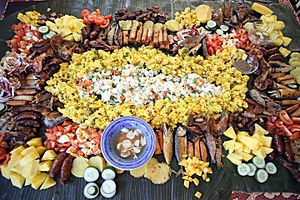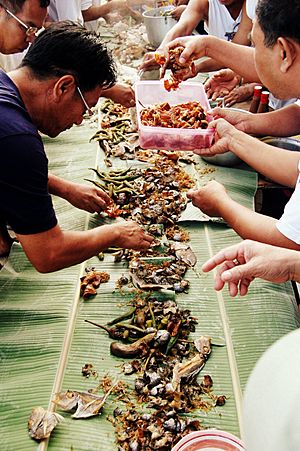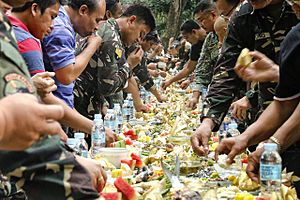Kamayan facts for kids
Kamayan is a special way of eating from the Philippines. The word "kamayan" means "eating with the hands." It's a traditional Filipino way to enjoy a meal without using forks or spoons. People often eat this way at a big group meal called a salu-salo. For these meals, food is usually spread out on fresh banana leaves.
Another name for kamayan is a boodle fight. This term is often used when soldiers in the Armed Forces of the Philippines share a meal together. It's a fun, communal way to eat.
Contents
What Does Kamayan Mean?
The words "kamayan" and "kinamot" both mean "eating with the hands." They come from the Filipino words for "hands": kamay (in Tagalog) and kamot (in Visayan).
The word "salu-salo" means a "feast" or a "banquet." It comes from the word salo, which means "to eat together" or "to share food."
The term "boodle fight" comes from American military slang. "Boodle" used to mean sweet treats like cake or candy. A "boodle fight" was a party where these treats were served. It might also come from the phrase "kit and caboodle," meaning "everything."
A Look Back: History of Kamayan
Eating with hands, or kamayan, is a very old tradition in the Philippines. It started long before other countries came to the islands. Explorers like Antonio Pigafetta wrote about Filipinos eating this way hundreds of years ago. Even during the time when Spain ruled the Philippines, this practice continued.
However, when Americans came to the Philippines, they tried to change this tradition. They wanted people to use spoons and forks, like they did in America. But even with these changes, many Filipinos still love and practice kamayan today.
How to Eat Kamayan Style
Kamayan is all about eating with your bare hands. It's a traditional way to enjoy food in Filipino culture. Here's how it's often done:
- First, you gather a small amount of rice.
- Then, you add a piece of the main dish, called ulam, for flavor.
- You gently press the rice and ulam together with your fingers to form a small pyramid.
- Next, you lift this little pyramid to your mouth using four cupped fingers.
- Finally, you use your thumb to push the food into your mouth.
Only the fingers of one hand are used for eating. Your palm should not touch the food, and your fingers should not go inside your mouth. Your other hand can be used to hold your plate or a drink.
Kamayan Feasts
Kamayan also describes big, shared meals, often with family or friends. For these feasts, rice and many colorful dishes are placed directly onto banana leaves. Everyone eats together from the same spread.
To prepare, the banana leaves are washed and slightly heated. This makes them soft and gives them a nice shine. Then, they are laid out on a long table. In the Batanes Islands, people sometimes use large breadfruit leaves instead. This tradition is called vunung or vunong.
The food is spread out evenly so everyone can reach it. You'll often find plain steamed white rice, sinangag (garlic rice), or rice cooked in coconut leaves (called puso).
What's on the Menu?
Many delicious Filipino dishes are served at a kamayan feast. These can include:
- Grilled Meats: Like inihaw (barbecues) or lechon (whole roasted pork).
- Fried Foods: Such as lumpia (spring rolls) or crispy pata (fried pork hock).
- Cured Meats: Like tocino (cured pork) and longganisa (sausages).
- Noodles: Such as pancit.
- Eggs: Boiled or salted eggs.
- Seafood and Vegetables: Fresh or stir-fried.
These dishes come with different dipping sauces, called sawsawan. You might find calamansi (a small lime), bagoong (fermented shrimp paste), or pickled vegetables (atchara).
For dessert, there are often fresh fruits like Philippine mangoes, pineapples, and watermelons. Sweet treats like leche flan (custard) and kakanin (rice cakes) are also popular. Drinks usually include fruit juices, or softdrinks. Soups and stews are usually not part of a kamayan meal.
Kamayan is a relaxed and friendly way to eat. It's all about sharing and talking with others during the meal. There aren't many strict rules, and the food served depends on what's available. You can have a kamayan meal at home with family, at parties, picnics, or during local festivals called fiestas. More and more Filipino restaurants are now offering meals served kamayan-style.
What is a Boodle Fight?
A boodle fight is a special kind of kamayan meal. It means eating without any cutlery (forks, spoons) or dishes. The food is laid out on a long table covered with banana leaves.
In the military, people don't sit in chairs for a boodle fight. Instead, they stand shoulder to shoulder in a line along both sides of the table.
A senior officer or soldier gives a special command to start the boodle fight:
"Ready on the left,
Ready on the right,
Commence boodle fight!"




